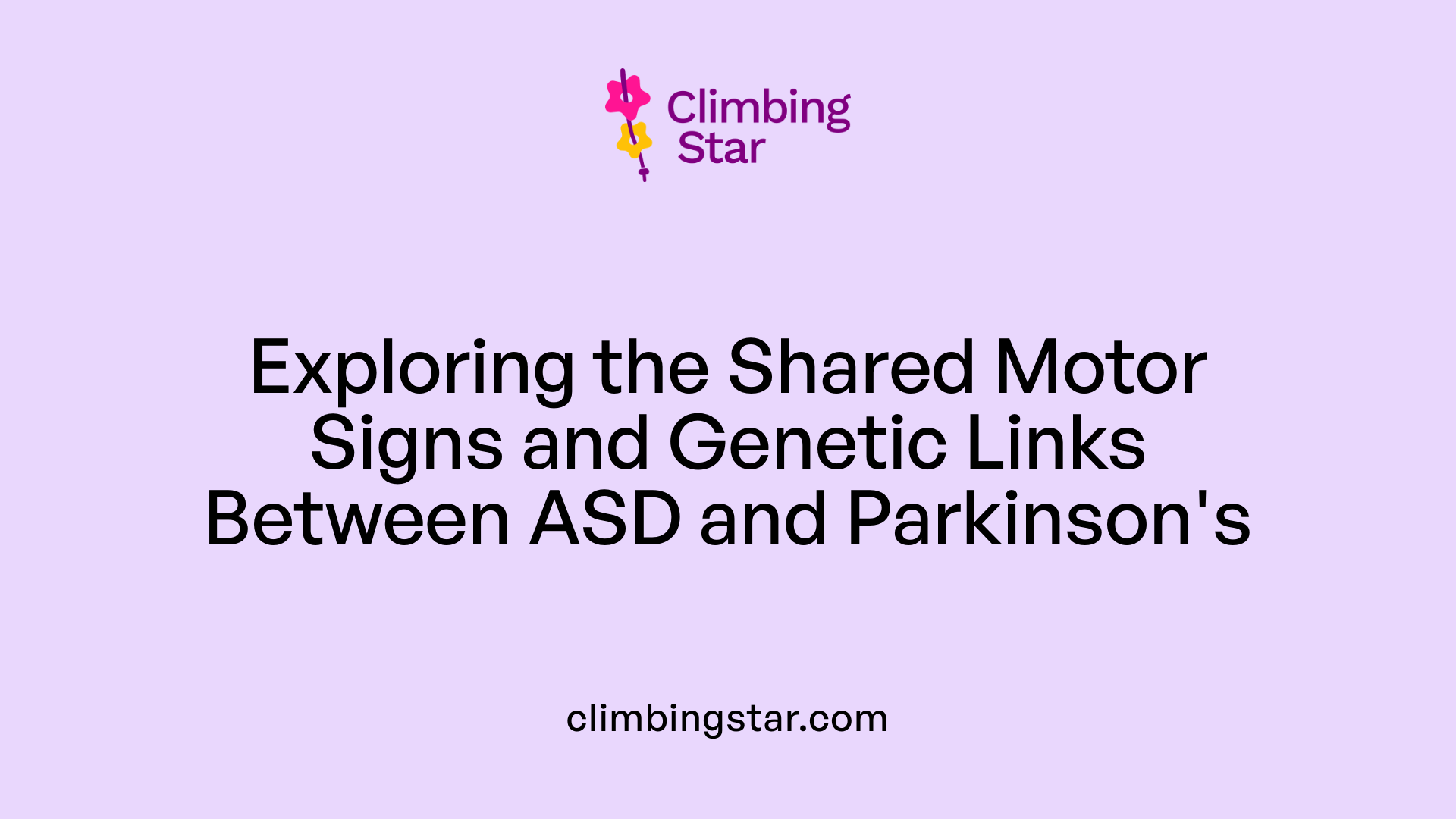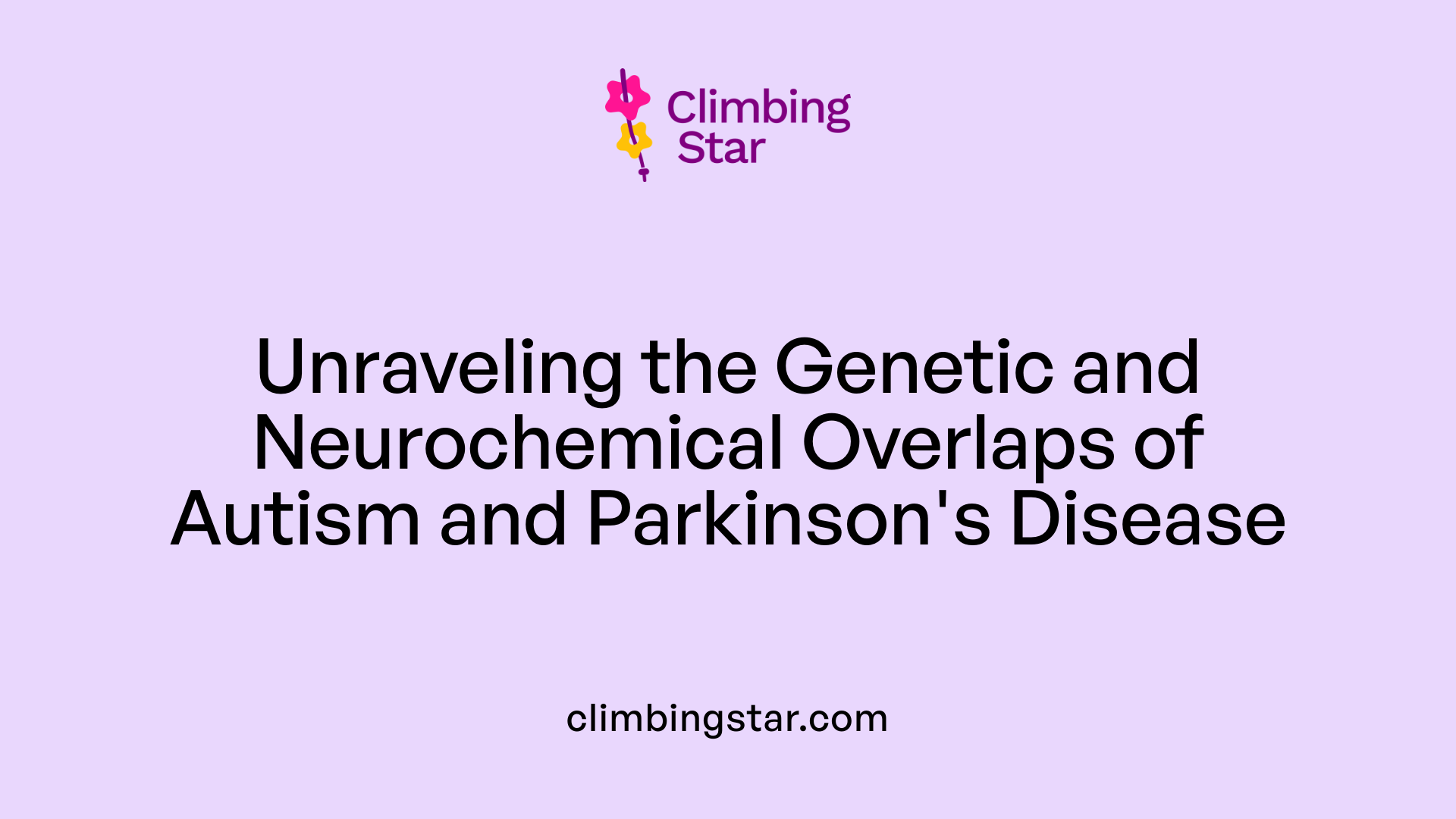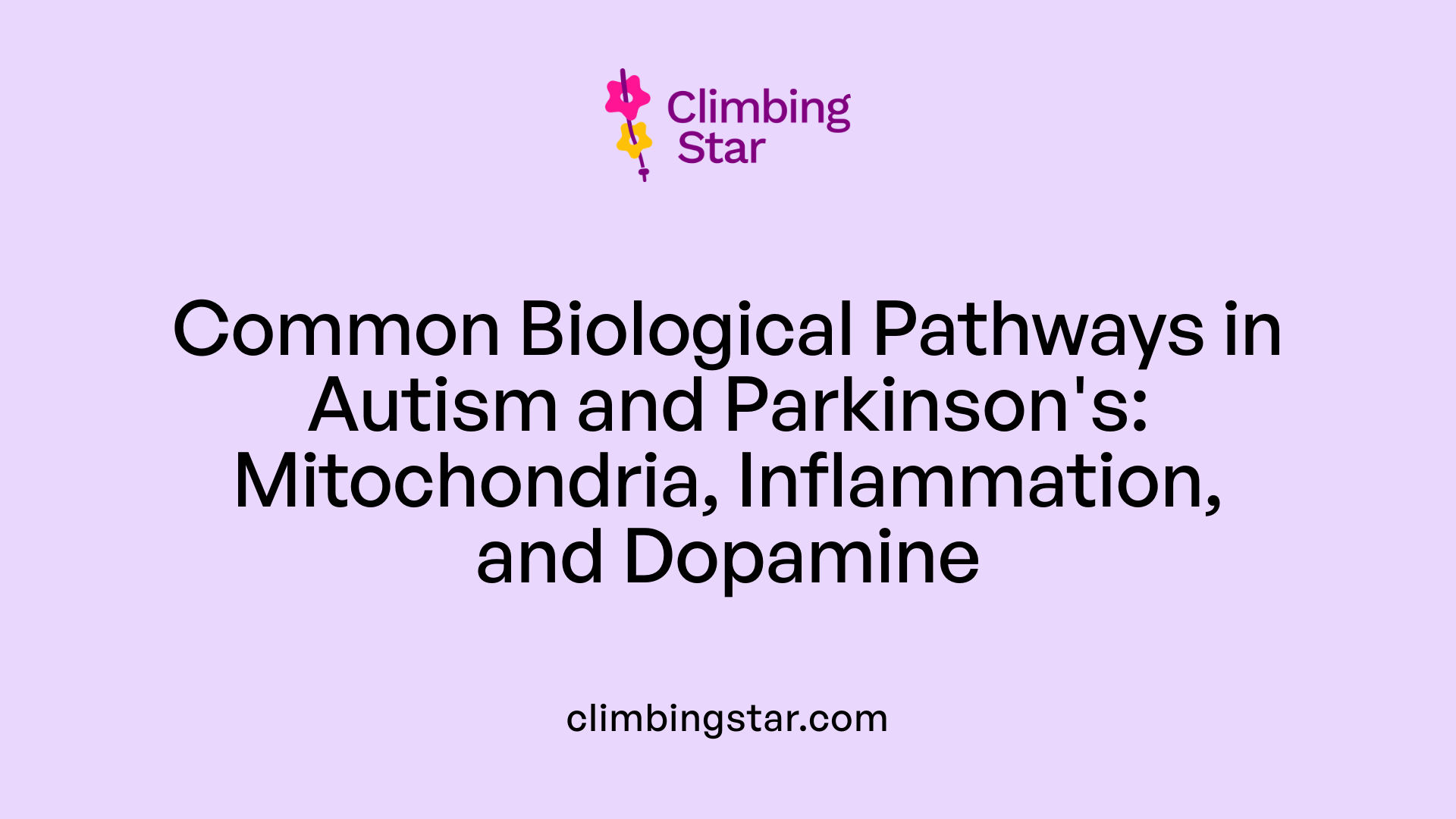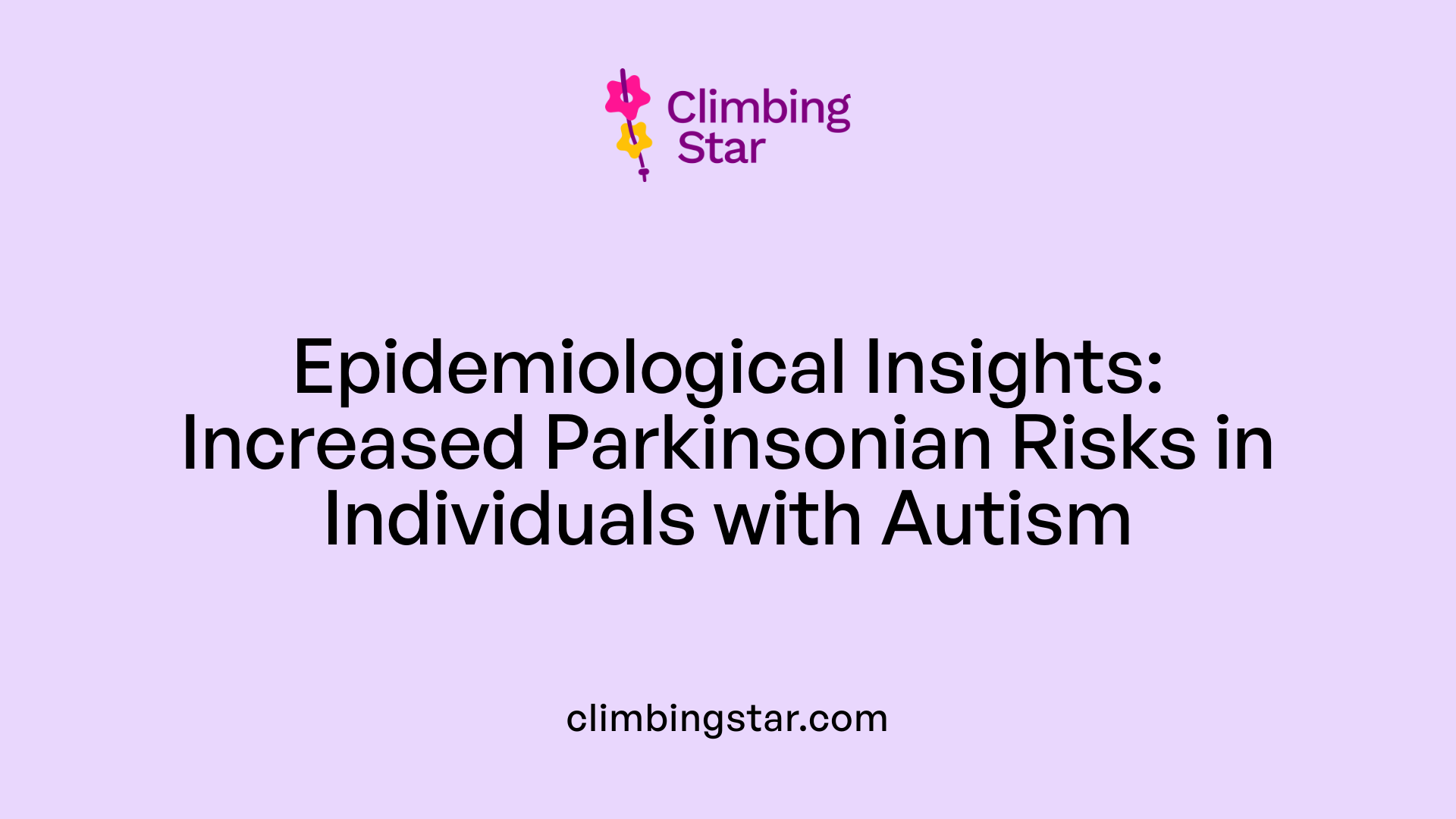Understanding the Overlap Between Neurodevelopmental and Neurodegenerative Disorders
Recent research reveals compelling connections between autism spectrum disorder (ASD) and Parkinson’s disease (PD), highlighting overlaps in clinical features, genetic susceptibility, shared biological pathways, and epidemiological risk factors. This emerging field underscores the importance of integrated approaches to diagnosis and treatment, and opens avenues for further exploration of common neurobiological mechanisms.
Clinical Features and Symptom Overlaps

What are the common clinical features and symptom overlaps between autism spectrum disorder (ASD) and Parkinson's disease?
Autism spectrum disorder (ASD) and Parkinson's disease (PD) share notable similarities in certain motor and social symptoms, which has led researchers to explore potential underlying links. One of the most significant overlaps is in motor signs. Individuals with ASD, especially conditions like Rett syndrome, often exhibit parkinsonian features such as bradykinesia (slowness of movement), rigidity, hypomimia (reduced facial expressions), and gait disturbances like freezing. Studies estimate that up to 80% of Rett syndrome patients display hypomimia, indicating a high prevalence of such features.
In addition to observable motor signs, genetic studies have uncovered shared pathways. Variations in genes such as PARK2, RIT2, and CD157/BST1 are more common in individuals with ASD and are associated with PD, pointing to overlapping genetic susceptibilities. Specifically, mutations in PARK2 impair mitochondrial function, leading to neuronal damage involved in PD, while similar genetic perturbations are linked to ASD.
From a neurobiological perspective, both conditions involve dysregulation of dopamine pathways and mitochondrial dysfunction, which play crucial roles in motor control and neurodegeneration. Brain areas affected in both ASD and PD include regions responsible for motor coordination and social behavior, further highlighting their interconnectedness.
While ASD primarily features challenges in social communication, repetitive behaviors, and sensory sensitivities, the shared motor signs and genetic links suggest that common neuroanatomical and molecular mechanisms may contribute to both disorders. Recognizing these overlaps can improve understanding of disease pathways and inform future research into targeted therapies.
Genetic and Neurobiological Connections
 Research indicates that there are indeed genetic and neurobiological links between autism and Parkinson's disease. Several genetic variations and mutations appear to be involved in both conditions, hinting at shared biological pathways. Notably, mutations in the PARK2 gene, which encodes an E3 ubiquitin ligase important for mitochondrial quality control, have been linked to both disorders. Dysfunctional mitophagy resulting from PARK2 mutations can lead to the accumulation of damaged mitochondria, contributing to neuronal death relevant in Parkinson's pathology.
Research indicates that there are indeed genetic and neurobiological links between autism and Parkinson's disease. Several genetic variations and mutations appear to be involved in both conditions, hinting at shared biological pathways. Notably, mutations in the PARK2 gene, which encodes an E3 ubiquitin ligase important for mitochondrial quality control, have been linked to both disorders. Dysfunctional mitophagy resulting from PARK2 mutations can lead to the accumulation of damaged mitochondria, contributing to neuronal death relevant in Parkinson's pathology.
Additionally, other genes such as RIT2 and CD157/BST1 have polymorphisms that are more frequently observed in individuals with ASD. These genes are implicated in neural processes including dopamine regulation, highlighting a neurobiological convergence.
The dopamine system plays a significant role here. Abnormalities in dopamine production and regulation are core features of Parkinson's disease. Interestingly, individuals with autism also show increased prevalence of parkinsonian features, including bradykinesia and gait freezing, suggesting disruptions in similar neurochemical pathways.
Research from large epidemiological studies supports these genetic insights, showing that people with autism have about a fourfold higher risk of developing Parkinson's, especially in early adulthood. This consistent association points to shared genetic vulnerabilities and neurobiological mechanisms that underpin both disorders, emphasizing the importance of further investigations into their common roots.
Shared Pathways and Neurobiological Mechanisms

What shared pathways and mechanisms are involved in autism and Parkinson's disease?
Research indicates that autism spectrum disorder (ASD) and Parkinson’s disease (PD) share several biological pathways that contribute to their development. Central to these are disruptions in mitochondrial function, which affects the cell’s energy production and can lead to neuronal damage. Mutations in genes like PARK2, which encodes an E3 ubiquitin ligase, impair mitophagy—the process of clearing damaged mitochondria—resulting in the accumulation of dysfunctional mitochondria that contribute to neurodegeneration in PD and potentially influence neurodevelopment in ASD.
Neuroinflammation is another common feature. Both conditions exhibit increased brain inflammation, which can cause oxidative stress—an imbalance between free radicals and antioxidants. Oxidative stress damages neurons, impacting their function and survival. This shared characteristic highlights inflammation as a potential therapeutic target for both disorders.
Genetic studies reveal overlaps in the genes associated with autism and Parkinson’s. Variations and deletions in PD-linked genes such as RIT2 and CD157/BST1 are more frequent in ASD, suggesting a shared genetic susceptibility. Mutations in genes like PINK1 further exemplify common pathways, as PINK1 is involved in mitochondrial quality control and its dysfunction leads to increased reactive oxygen species (ROS), promoting neurodegeneration.
Dysregulation of dopamine pathways is a hallmark of PD and is increasingly recognized in ASD. Dopamine influences movement, social behaviors, and reward processing. Both disorders involve abnormalities in dopaminergic signaling, which can stem from genetic mutations affecting dopamine synthesis, transport, and receptor function. This convergence suggests that disruptions in dopamine-related pathways are central to both neurodevelopmental and neurodegenerative processes.
Collectively, these shared pathways—encompassing mitochondrial dysfunction, neuroinflammation, oxidative stress, and dopamine dysregulation—point to overlapping mechanisms that underlie the pathology of both ASD and PD. Understanding these commonalities can open avenues for integrated treatment strategies targeting these fundamental neurobiological processes.
Epidemiological Evidence and Risk Factors

Is there epidemiological evidence suggesting that autism is associated with an increased risk of Parkinsonian symptoms later in life?
Recent large-scale studies provide compelling evidence of a close link between autism spectrum disorder (ASD) and an increased likelihood of developing Parkinsonian symptoms, including Parkinson's disease (PD). One prominent cohort study from Sweden, involving over 2.2 million individuals followed from 1974 to 2022, found that those with ASD had more than four times the risk of developing PD compared to people without ASD. Specifically, 0.05% of individuals with ASD were diagnosed with Parkinson’s, versus 0.02% of controls. This elevated risk was particularly notable before age 50, with all Parkinson’s cases in the study occurring early, suggesting an association with early-onset PD.
Further investigations reveal that people with ASD are more prone to motor symptoms such as tremors, rigidity, and gait freezing—features characteristic of parkinsonism. In disorders like Rett syndrome, which falls within the autism spectrum, these features manifest widely, with prevalence estimates for hypomimia (reduced facial expression) ranging from 40% to 80%.
Genetic research supports the epidemiological findings, indicating shared genetic susceptibilities. Variations in genes like PARK2, RIT2, and CD157/BST1 are found more frequently in ASD cases and are implicated in PD development. For instance, the PARK2 gene, involved in mitochondrial quality control, when mutated, may contribute to neuronal death relevant to both ASD and PD.
Other factors influencing the association include medications. Use of antipsychotics in individuals with ASD appears to reduce some risk estimates but does not eliminate the connection between ASD and PD. Similarly, depression and antidepressant use are associated with a doubled risk of Parkinson’s among those with autism.
Overall, these epidemiological findings demonstrate a significant association between ASD and the development of Parkinsonian features later in life. They underscore the importance of long-term medical oversight for autistic individuals, considering potential neurological risks and the potential shared biological pathways involving inflammation and dopaminergic system dysregulation.
| Study Aspect | Findings | Additional Details |
|---|---|---|
| Population size | Over 2 million in Swedish cohort | Birth years 1974–1999, followed until 2022 |
| PD prevalence in ASD | 0.05% | Compared to 0.02% in controls |
| Age of PD onset | Usually before age 50 | Signaling early-onset PD |
| Genetic overlap | Variations in PARK2, RIT2, CD157/BST1 | Genes involved in mitochondrial function and neuronal health |
| Influence of medications | Antipsychotics slightly reduce risk | But do not fully negate ASD-PD link |
| Other risk factors | Depression and antidepressant use | Associated with doubled PD risk |
This body of evidence highlights a crucial need for ongoing research on neurodevelopmental and neurodegenerative links, aiming to improve early detection, intervention, and understanding of shared underlying mechanisms.
Impact of Autism on Parkinson’s Disease Development
Does having autism influence the likelihood of developing Parkinson's-related symptoms in later life?
Research shows that individuals with autism spectrum disorder (ASD) are more prone to developing Parkinson's disease (PD) compared to the general population. Large-scale studies, particularly from Sweden, have found that autistic individuals are over four times more likely to receive a PD diagnosis, with a median age of onset around 34 years. This suggests a strong connection to early-onset Parkinson’s, which typically affects older adults.
The biological basis for this increased risk appears to involve shared mechanisms in the brain. Both autism and PD impact dopaminergic neurons, crucial for movement and behavior regulation. Genetic studies highlight mutations in genes such as PARK2, RIT2, and others involved in mitochondrial function and neurodegeneration as common factors.
While some movement issues in autism can resemble Parkinsonian signs, the significant rise in PD diagnoses among autistic individuals indicates a genuine increased risk, not just diagnostic confusion. The evidence points to an underlying biological link, likely involving dopamine system dysregulation and genetic susceptibilities.
Considering these findings, healthcare providers are encouraged to maintain vigilant, long-term monitoring of individuals with autism, especially as they age. Recognizing early signs of Parkinson's can facilitate timely intervention and management, potentially improving long-term health outcomes.
Inflammation’s Role in Autism and Parkinson’s Disease
Neuroinflammation markers
Research indicates that neuroinflammation is a common feature in both autism spectrum disorder (ASD) and Parkinson's disease (PD). Elevated levels of inflammatory mediators such as cytokines (IL-1β, IL-6, and TNF-α) are found in the brains of individuals with these conditions. Microglia, the brain’s resident immune cells, become activated during neuroinflammation, releasing cytokines and other substances that can damage neurons. Markers like high mobility group box-1 (HMGB1), which signals immune activation, are elevated in both ASD and PD, serving as indicators of ongoing inflammation.
Impact of immune responses
The immune system’s involvement plays a crucial role in the development and progression of both disorders. In autism, immune dysfunction during critical periods of brain development can interfere with neuronal growth, synapse formation, and neural network maturation. This disruption may contribute to behavioral and cognitive challenges characteristic of ASD.
In Parkinson's disease, chronic neuroinflammation accelerates the loss of dopaminergic neurons in the substantia nigra. Microglial activation and the release of inflammatory cytokines create a toxic environment, promoting neurodegeneration. Genetic factors, such as mutations in the PARK2 and PINK1 genes, which affect mitochondrial health, further exacerbate inflammation, linking metabolic dysfunction to immune responses.
Potential for anti-inflammatory interventions
Reducing brain inflammation offers a promising approach to managing both autism and Parkinson’s disease. Anti-inflammatory diets rich in omega-3 fatty acids, green leafy vegetables, nuts, and seeds can help lower systemic and neuroinflammation. Pharmacological strategies targeting cytokines or immune pathways, like HMGB1 inhibitors, are under investigation for their potential to prevent neuronal damage.
Controlling inflammation not only offers a way to potentially slow disease progression but also to improve top-down management of symptoms. Early intervention with anti-inflammatory approaches might support neurodevelopmental processes in children with ASD, while in Parkinson’s, it could help preserve neuronal function longer.
| Aspect | Role in Autism | Role in Parkinson’s | Shared Implication |
|---|---|---|---|
| Inflammation markers | Elevated cytokines, HMGB1 | Activated microglia, cytokines | Common immune activation indicators |
| Immune responses | Disrupted neural development | Accelerated neuronal death | Neuroinflammation as a treatment target |
| Interventional potential | Dietary and drug anti-inflammatories | Inflammation management to slow progression | Possibility for unified therapeutic strategies |
Understanding the interplay between inflammation and these neurological conditions emphasizes the importance of immune health in brain disorders. Advances in anti-inflammatory treatments could offer promising avenues for future therapies, providing relief and slowing progression of both autism spectrum disorder and Parkinson's disease.
Implications and Future Directions for Research and Care
The accumulating evidence of overlapping features, genetic and biological pathways, and shared inflammatory processes underscores the importance of a multidisciplinary approach to understanding autism and Parkinson’s disease. Recognizing the potential for early identification of at-risk individuals can inform preventative strategies and personalized interventions. As research continues to unravel the complex mechanisms linking these disorders, future therapies targeting common pathways such as mitochondrial integrity, dopamine regulation, and neuroinflammation hold promise for improving outcomes. Long-term health monitoring and comprehensive care will be crucial as the autism population ages, with the goal of reducing the burden of neurodegenerative symptoms and enhancing quality of life.
References
- Linking autism spectrum disorders and parkinsonism
- Risk of Parkinson Disease in Individuals With Autism ...
- Daily briefing: Autism triples risk of Parkinson's-like symptoms
- Large-scale study links autism to increased risk of ...
- Autism linked to elevated risk of Parkinson's disease
- Exploring the common genes involved in autism spectrum ...
- Risk of Parkinson Disease in Individuals With Autism ...
- What Do Autism and Parkinson's Have in Common?
- Linking autism spectrum disorders and parkinsonism
- Autism linked to elevated risk of Parkinson's disease







